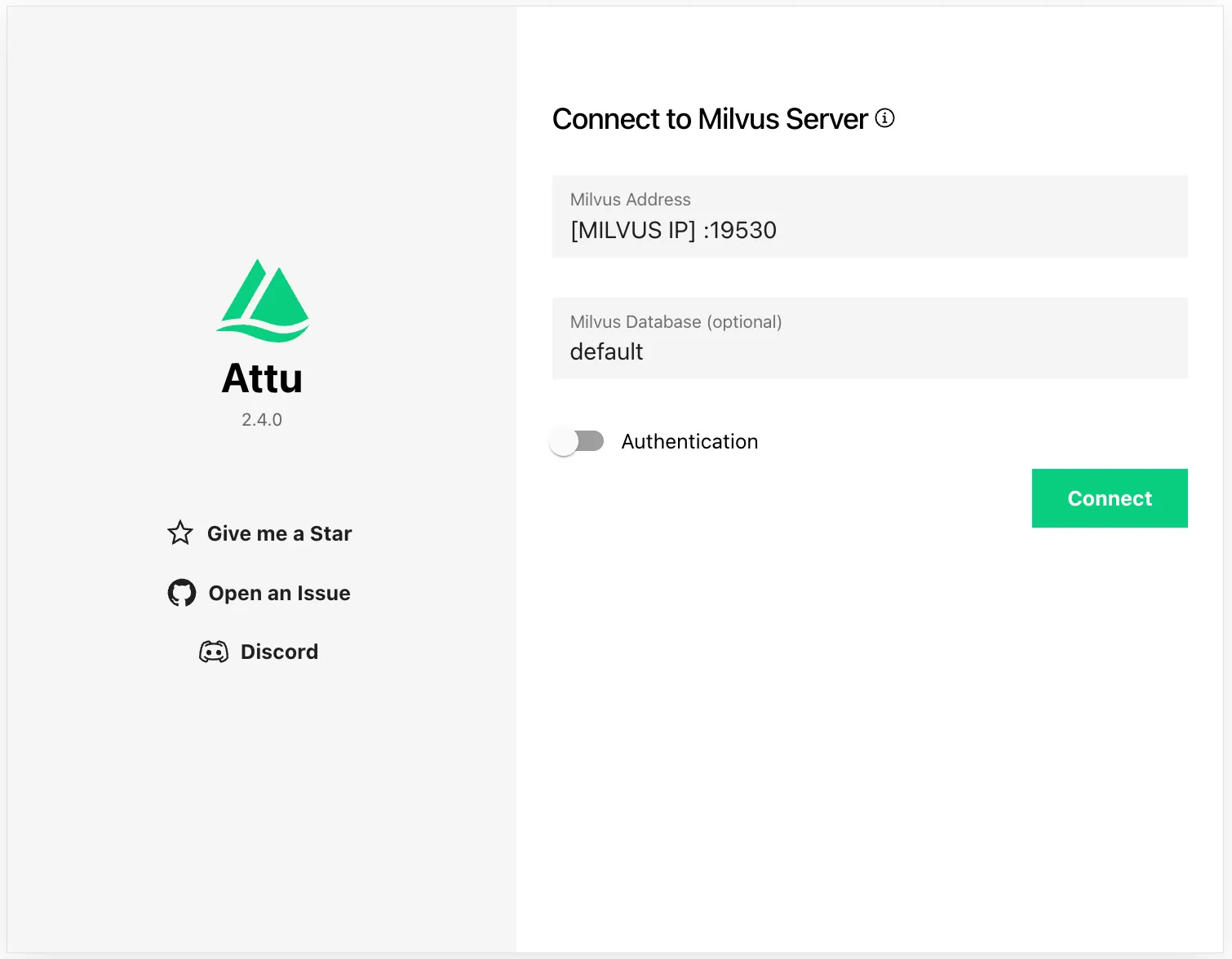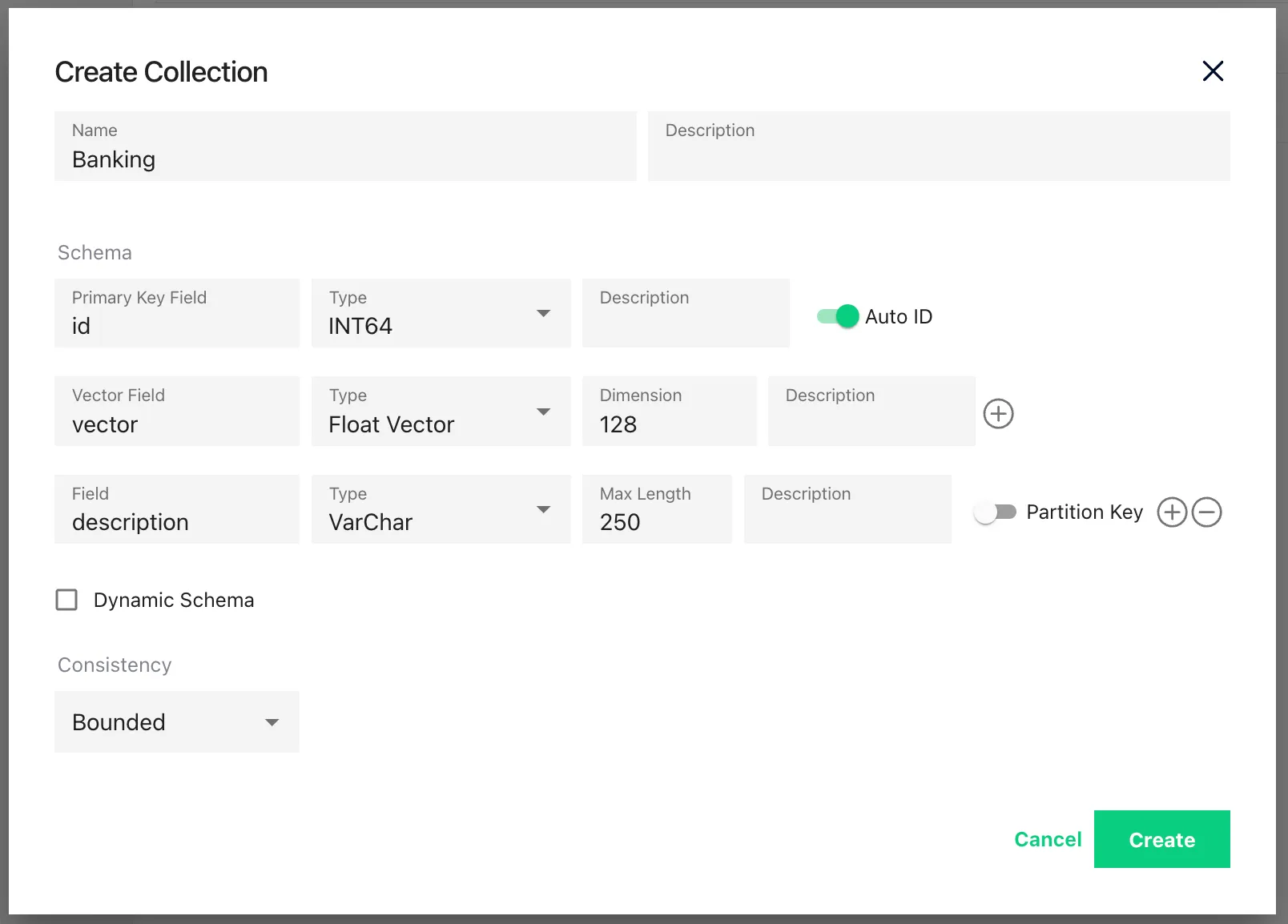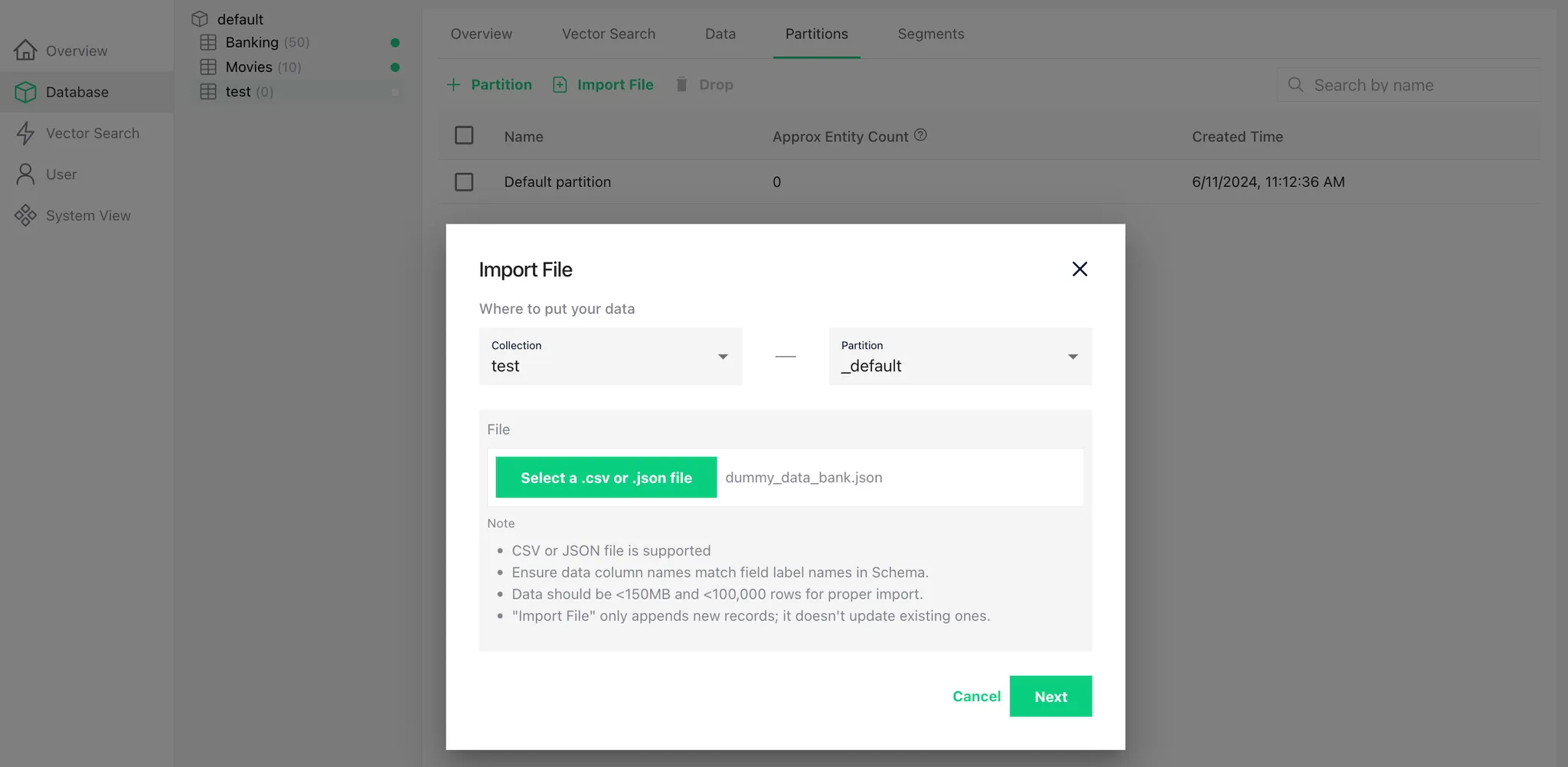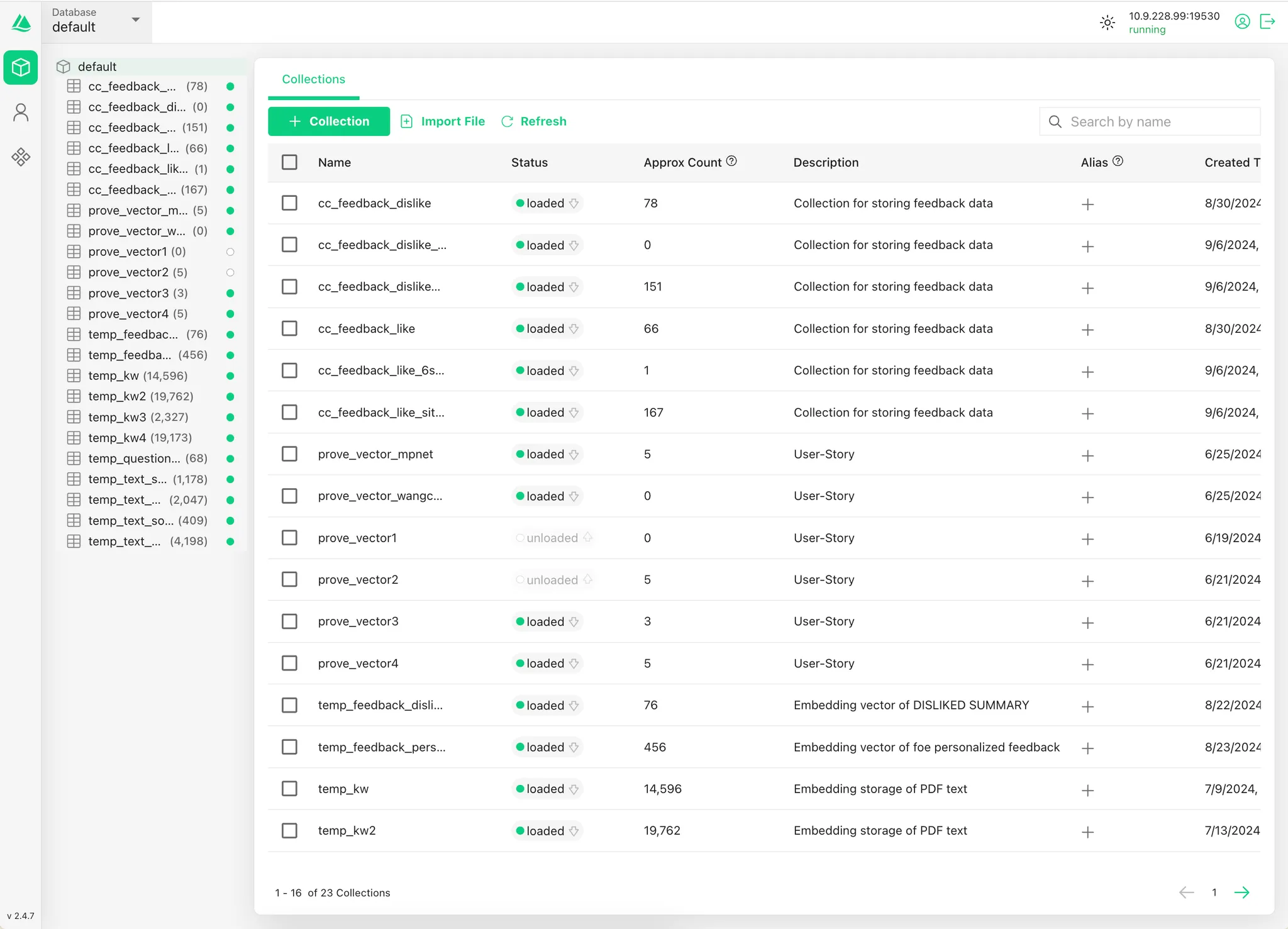How to LLM+RAG with Milvus VectorDB WALKTHROUGH
Quick notes on my device specifications
MacOS Sonoma
Macbook Pro 16 2023
Installing Milvus
Install Docker
Docker download link: https://docs.docker.com/desktop/install/mac-install/
Install Milvus via Docker Compose
Milvus provides a Docker Compose configuration file in the Milvus repository. To install Milvus using Docker Compose:
- Navigate to the directory, which you wished to install Milvus in
- Run the following
wget https://github.com/milvus-io/milvus/releases/download/v2.4.4/milvus-standalone-docker-compose.yml -O docker-compose.yml
Install via Docker Compose using the downloaded .yml file
sudo docker compose up -d
After starting up Milvus,
- Containers named milvus-standalone, milvus-minio, and milvus-etcd are up.
- The milvus-etcd container does not expose any ports to the host and maps its data to volumes/etcd in the current folder.
- The milvus-minio container serves ports 9090 and 9091 locally with the default authentication credentials and maps its data to volumes/minio in the current folder.
- The milvus-standalone container serves ports 19530 locally with the default settings and maps its data to volumes/milvus in the current folder.

You can check if the containers are up and running using the following command:
sudo docker compose ps
You can stop and delete this container as follows
sudo docker compose down
sudo rm -rf volumes
Installing Attu
Attu, a GUI for Milvus, using Docker: https://github.com/zilliztech/attu
First get your IP
ipconfig getifaddr en0
MILVUS IP below should be changed into your IP.
docker run -p 8000:3000 -e MILVUS_URL={MILVUS IP}:19530 zilliz/attu:v2.4.0
Make sure that the Attu container can access the Milvus IP address. After starting the container, open your web browser and enter http://{ Attu IP }:8000 to view the Attu GUI.
Notes on Docker & Podman Situation
Firstly, Podman can be download in the following link: https://podman-desktop.io/
After the installation of Podman, you can see Podman Desktop being installed in your device, the syntax usage is similar to that of Docker’s, for example -
Using Docker, the following syntax is used
docker run -p 8000:3000 -e MILVUS_URL={milvus server IP}:19530 zilliz/attu:v2.4
But in Podman, the following will be used instead, you can observe that the only change is the command from docker to podman
podman run -p 8000:3000 -e MILVUS_URL={milvus server IP}:19530 zilliz/attu:v2.4
Afterwards, the container can be shown running in the Podman user interface in Podman Desktop.
Afterwards, the container can be shown running in the Podman user interface in Podman Desktop.

Container status as shown in Podman interface
Validate Installations
Validating Milvus
Create a file: milvus_standalone.py
from pymilvus import connections, utility, MilvusException
connections.connect(host="localhost", port="19530")
try:
# List all collections
collections = utility.list_collections()
print(f"List all collections:\n", collections)
except MilvusException as e:
print(e)
If you run milvus_standalone.py, you should get the following response:
List all collections:
[]
Validating Attu
Attu should be located in your local host port 8000

Click Connect and you should be redirected to the GUI. Enable Authentication for additional credentials if needed.
Connection
Establish Connection to Milvus
Below example connects to a Milvus server with host as localhost and port as 19530 and disconnects from it.
Example Code for Milvus Connection
Establishing Connection:
from pymilvus import connections, FieldSchema, CollectionSchema, DataType, Collection, utility
MILVUS_HOST = '{milvus_host}'
MILVUS_PORT = '19530'
MILVUS_USER = '{user}'
MILVUS_PASSWORD = '{password}'
connections.connect(
alias='default',
host=MILVUS_HOST,
port=MILVUS_PORT,
user=MILVUS_USER,
password=MILVUS_PASSWORD
)
Terminating Connection:
connections.disconnect(alias="default")
The maximum number of connections is 65,536.
Create, Load and Monitor Collections
Create Collection Via Attu
After logging in, you will be greeted with the main dashboard. From this page, you can navigate to the Database tab.
 Dashboard of Attu
Dashboard of Attu
 Collection Screen
Collection Screen
From this tab, you can click the + Collection button to create a new collection. Fill in the informations according to the vector csv that you have generated. (be sure to set the max length of the description field to properly accommodate your data.)

Once you have created the collection you will have a new collection appears in your defualt database. Now you can navigate to Partitions tab inside your new collection, and click import data

After that you have to go back to Overview tab and click + Create Index . In the pop-up window, name your index, and then set the Metric type to L2 (Or any metrics that you need to use, which we will discuss this in a later section). Then hit Create .

Finally, click unloaded to load the data as below, this will take a minute. And now the collection is loaded and ready to be use!!!! 🥳

Create Collection Via Code
Creating collection via code can be done by the following steps
1 Define Connection to Milvus
Same principle as the aforementioned importance of defining the connection to Milvus Establish Connection to Milvus, which can be done with the following lines of code:
from pymilvus import connections, FieldSchema, CollectionSchema, DataType, Collection, utility
connections.connect(
alias='default',
host=MILVUS_HOST,
port=MILVUS_PORT,
user=MILVUS_USER,
password=MILVUS_PASSWORD
)
2 Define Schemas
After defining connection to Milvus, you can set parameters of each fields within the schemas that you are going to create. Using the FieldSchema class - more details can be found here (https://milvus.io/docs/schema.md#Field-schema)
fields = [
FieldSchema(name="search_uuid", dtype=DataType.VARCHAR, max_length=1024, is_primary=True, auto_id=False),
FieldSchema(name="keyword_search", dtype=DataType.VARCHAR, max_length=1024),
FieldSchema(name="embeddings", dtype=DataType.FLOAT_VECTOR, dim=768),
FieldSchema(name="summary", dtype=DataType.VARCHAR, max_length=1024),
FieldSchema(name="user_ids", dtype=DataType.VARCHAR, max_length=1024)
]
schema = CollectionSchema(fields=fields, description="Collection for storing feedback data")
3 Create Collection
Script to check if the Database already contain the collection
if not utility.has_collection(collection_name):
collection = Collection(name=collection_name, schema=schema)
print(f"Collection '{collection_name}' created.")
else:
collection = Collection(name=collection_name)
print(f"Collection '{collection_name}' already exists.")
4 Define and Create Index
Define index within the collection, a collection needs to have index first before the ability to be loaded.
index_params = {
"index_type": "IVF_FLAT",
"metric_type": "COSINE",
"params": {
"nlist": 128
}
}
collection.create_index(
field_name="embeddings", # Corrected from 'embedding' to 'embeddings'
index_params=index_params,
index_name="ivt_flat_128"
)
5 Load Collection
Load the collection to be able to utilize the semantic search within the collection.
collection.load()
Example Code for Creating Collection
Now we can put together the codes above, which will combined into a collection creating and loading script like below.
# 1 Define connection to Milvus
connections.connect(
alias='default',
host=MILVUS_HOST,
port=MILVUS_PORT,
user=MILVUS_USER,
password=MILVUS_PASSWORD
)
# 2 Define field schemas
fields = [
FieldSchema(name="search_uuid", dtype=DataType.VARCHAR, max_length=1024, is_primary=True, auto_id=False),
FieldSchema(name="keyword_search", dtype=DataType.VARCHAR, max_length=1024),
FieldSchema(name="embeddings", dtype=DataType.FLOAT_VECTOR, dim=768),
FieldSchema(name="summary", dtype=DataType.VARCHAR, max_length=1024),
FieldSchema(name="user_ids", dtype=DataType.VARCHAR, max_length=1024)
]
schema = CollectionSchema(fields=fields, description="Collection for storing feedback data")
# 3 Create collection
collection_name = "your_collection_here"
# Check if the collection exists, if not, create it
if not utility.has_collection(collection_name):
collection = Collection(name=collection_name, schema=schema)
print(f"Collection '{collection_name}' created.")
else:
collection = Collection(name=collection_name)
print(f"Collection '{collection_name}' already exists.")
# 4 Define and Create Index for the collection
index_params = {
"index_type": "IVF_FLAT",
"metric_type": "COSINE",
"params": {
"nlist": 128
}
}
collection.create_index(
field_name="embeddings", # Corrected from 'embedding' to 'embeddings'
index_params=index_params,
index_name="ivt_flat_128"
)
# 5 Load collection
collection.load()
Collection Monitoring
Below are a few pointers for maintaining and monitoring Milvus Database via Attu user interface.
 Collections in Database Page
Collections in Database Page
 Collection Overview Page
Collection Overview Page
Database Page
- On the left tab, below the default database name, shows the list of existing collections within the current database.
- The main right tab is a more detailed visualization of the collections within the database, shown along their respective attributes - name, status (loaded/unloaded), etc.
- From this page, you can monitor an approximation of entities that exists within each collection, and also their load status, meaning if they are ready to be vector searched or not (more on in the later section).
- Additionally, you can also create new collection from the UI in this page, as mentioned above.
Collection Detail Page
- Once you clicked one of the collection from the collection list in the Database page, you will be greeted with Collection Overview Page.
- In this page, you can monitor more in-depth details of each of the collections, most importantly - the schema of each collection.
- Each collection’s schemas are shown in their respective Overview pages, this will tells you details such as - Field names and their limitations, and most importantly their respective primary key types, which will be explained below [Notes on Primary Key (AutoID vs Unique ID)
Notes on Primary Key (AutoID vs Unique ID)

AutoID Enabled
AutoID is an attribute of the primary field that determines whether to enable AutoIncrement for the primary field. The value of AutoID is defined based on a timestamp, allows the primary field to automatically increment

AutoID Disabled
The following is an example - FieldSchema(name="temp", dtype=DataType.VARCHAR, max_length=1024, is_primary=True, auto_id=False) , the primary will be non-incremental, which will allow us to perform an upsert within the collection.
Dropping Collection
from pymilvus import utility
utility.drop_collection("book")
Insert, Upsert, Delete
Insert
To insert entities into a collection, use the insert() method.
def insert_into_milvus(collection, data, token):
connections.connect(
alias='default',
host=MILVUS_HOST,
port=MILVUS_PORT,
user=MILVUS_USER,
password=MILVUS_PASSWORD
)
# Extract and prepare the data lists
keyword_search = [item['keyword_search'] for item in data]
document_topic = [item['document_topic'] for item in data]
# Embed the text (either 'question' or 'summary') depending on the collection
embeddings = [get_embedding(token, keyword_search) for item in data]
# Insert data into the collection
collection.insert([
keyword_search,
embeddings,
document_topic
])
print(f"Inserted {len(data)} records into '{collection.name}'.")
Upsert
In Milvus, an upsert operation performs a data-level action to either insert or update an entity based on whether its primary key already exists in a collection. Specifically:
- If the primary key of the entity already exists in the collection, the existing entity will be overwritten.
- If the primary key does not exist in the collection, a new entity will be inserted.
- Upsert operations will not update the primary keys.
- Upsert operations does not support collections with
autoIDenabled.
def insert_into_milvus(collection, data, token):
connections.connect(
alias='default',
host=MILVUS_HOST,
port=MILVUS_PORT,
user=MILVUS_USER,
password=MILVUS_PASSWORD
)
# Extract and prepare the data lists
search_uuids = [item['search_uuids'][0] for item in data] # Use the first UUID as the primary key
keyword_search = [item['keyword_search'] for item in data]
document_topic = [item['document_topic'] for item in data]
# Embed the text (either 'question' or 'summary') depending on the collection
embeddings = [get_embedding(token, keyword_search) for item in data]
# Insert data into the collection
collection.upsert([ # Notice upsert
search_uuids, # search_uuid is implemented in order to upsert
keyword_search,
embeddings,
document_topic
])
print(f"Inserted {len(data)} records into '{collection.name}'.")
Delete
Milvus offers two ways for you to identify the entities to delete.
Delete entities by filter.
When using filter expressions to delete entities, ensure the collection has been loaded. Otherwise, Milvus will return an error.
collection = Collection("temp_collection_001")
collection.delete("id in [001,002,003]")
Delete entities by IDs.
The following snippets demonstrate how to delete entities by IDs from a specific partition. It also works if you leave the partition name unspecified.
collection = Collection("temp_collection_001")
collection.delete("search_uuid == 'temp_uuid_0001'")
collection = Collection("temp_collection_001")
expr="""
user_ids == 'POCGenAi03' and keyword_search == 'ลูกค้าสมัคร promptpay ได้อย่างไร' and document_topic == 'สมัครพร้อมเพย์ (SUPER USER).pdf' and summary =="ลูกค้าสามารถสมัครพร้อมเพย์ผ่านระบบ Krungthai Corporate Online โดยทำตามขั้นตอนในเอกสาร 'การลงทะเบียนข้อมูลผู้ใช้งานพร้อมเพย์นิติบุคคล' โดยใช้ Super User"
"""
collection.delete(expr)
Delete Entire Collection (Empty the whole collection)
BE CAEFUL! This will select all the entities in the collection and delete them.
from pymilvus import connections, FieldSchema, CollectionSchema, DataType, Collection, utility
def connect():
connection = None
try:
connection = psycopg2.connect(
host=PG_HOST,
database=PG_DATABASE,
port=PG_PORT,
user=PG_USER_UAT,
password=PG_PASSWORD_UAT
)
except Exception as error:
print(f"Error: {error}")
return None
return connection
MILVUS_HOST = '10.9.228.99'
MILVUS_PORT = '19530'
MILVUS_USER = 'root'
MILVUS_PASSWORD = 'Milvus'
connections.connect(
alias='default',
host=MILVUS_HOST,
port=MILVUS_PORT,
user=MILVUS_USER,
password=MILVUS_PASSWORD
)
collection = Collection("test_delete")
expr="search_uuid!=''"
collection.delete(expr)
Semantic Search (Vector Search)
Semantic search compares your query vector with the existing vectors in your collection and returns the IDs of the closest matches along with the distances between them. Optionally, it can also return the vector values and metadata of the results.
Metrics
The followinf section will be going over in a brief details of the metrics that can be used to calculate our vector similarities
Common Metrics Types for Semantic Search:
- Euclidean distance (L2)
- Inner product (IP) (Not relevant in our use case)
- Cosine similarity (COSINE) *
Euclidean distance (L2)
Essentially, Euclidean distance measures the length of a segment that connects 2 points.

euclidean
where a = (a0, a1,…, an-1) and b = (b0, b0,…, bn-1) are two points in n-dimensional Euclidean space
It’s the most commonly used distance metric and is very useful when the data are continuous.
Milvus only calculates the value before applying square root when Euclidean distance is chosen as the distance metric.
Cosine similarity (COSINE) *
Cosine similarity uses the cosine of the angle between two sets of vectors to measure how similar they are. You can think of the two sets of vectors as two line segments that start from the same origin ([0,0,…]) but point in different directions.
To calculate the cosine similarity between two sets of vectors A = (a0, a1,…, an-1) and B = (b0, b1,…, bn-1), use the following formula:

cosine_similarity
The cosine similarity is always in the interval [-1, 1]. For example, two proportional vectors have a cosine similarity of 1, two orthogonal vectors have a similarity of 0, and two opposite vectors have a similarity of -1. The larger the cosine, the smaller the angle between two vectors, indicating that these two vectors are more similar to each other.
By subtracting their cosine similarity from 1, you can get the cosine distance between two vectors.
Metric Type In-Use
While cosine looks at the angle between vectors (thus not taking into regard their weight or magnitude), euclidean distance is similar to using a ruler to actually measure the distance.
Generally COSINE metrics works better with document type queries
Cosine similarity is generally used as a metric for measuring distance when the magnitude of the vectors does not matter. This happens for example when working with text data represented by word counts. We could assume that when a word (e.g. science) occurs more frequent in document 1 than it does in document 2, that document 1 is more related to the topic of science. However, it could also be the case that we are working with documents of uneven lengths (Wikipedia articles for example). Then, science probably occurred more in document 1 just because it was way longer than document 2. Cosine similarity corrects for this.
Text data is the most typical example for when to use this metric. However, you might also want to apply cosine similarity for other cases where some properties of the instances make so that the weights might be larger without meaning anything different. Sensor values that were captured in various lengths (in time) between instances could be such an example.
Vector Search in Milvus
Example
Example Use-Case: Similar entity querying
This function can be use to only query the most similar entity in the collection, with an adjustable threshold.
# Print Top-5 similar questions
def top_similar(text, nprobe=128, limit=5):
collection = Collection("temp_question_feedback2")
tokens = getCredential('./credential/ktb-contact-center-nonprd-vertexai.json')
token = tokens['Token']
text_to_search = text
query_embedding = call_embedding(token, 'http://10.9.93.83:8443/contactcenter-textembedding', text_to_search)
search_params = {"metric_type": "COSINE", "params": {"nprobe": nprobe}}
similarity_search_result = collection.search(
data=[query_embedding],
anns_field="embedding",
param=search_params,
limit=limit,
output_fields=['search_uuid' ,'question', 'summary']
)
for hit in similarity_search_result[0]:
uuid = hit.entity.get("search_uuid")
question = hit.entity.get("question")
summary = hit.entity.get("summary")
distance = hit.distance
if distance > 0.945: # Adjust this value to suit the application
match = True
print(f"Question: {question}, Distance: {distance}")
return match, uuid, question, summary
Example Use-Case: Streaming search
This is an example script to test the distance and the query capacity of the created collection, the main benefit form this script, is that you can quickly see the distance differences between each queries for a quick comparison.
import numpy as np
from pymilvus import connections, Collection, MilvusException
from typing import List, Optional
import requests
try:
while True:
tokens = getCredential('./credential/ktb-contact-center-nonprd-vertexai.json')
token = tokens['Token']
# Get user input for PDF description or exit
user_input = input("\n======================================================================\nDescribe what would you like to know (or type 'exit' to quit):\n")
# Exit loop if user types 'exit'
if user_input.lower() == 'exit':
break
# Process user input using the Sentence Transformer model to get the embedding vector
user_vector = get_embedding(token, user_input)
# Ensure the vector matches the expected dimension
# Milvus expects 3072 bytes which is 768 floats (since 1 float = 4 bytes)
expected_dimension = 768
current_dimension = len(user_vector)
if current_dimension < expected_dimension:
user_vector = np.pad(user_vector, (0, expected_dimension - current_dimension), 'constant')
elif current_dimension > expected_dimension:
user_vector = user_vector[:expected_dimension]
# user_vector = user_vector.tolist()
# Define search parameters for similarity search
search_params = {
"metric_type": "COSINE",
"params": {"nprobe": 10}
}
# Connect to the Milvus collection named "temp"
collection = Collection("temp")
# Perform similarity search using Milvus
similarity_search_result = collection.search(
data=[user_vector],
anns_field="embedding",
param=search_params,
limit=50,
# output_fields=['source', 'text']
output_fields=['source']
)
# Display search results to the user and get the top result
top_result = None
for idx, hit in enumerate(similarity_search_result[0]):
score = hit.distance
filename = hit.entity.get("source")
# summary = hit.entity.get("text")
print(f"{idx + 1}. Filename: {filename} (distance: {score})")
# print(f"Summary: {summary}\n")
if idx == 0:
top_result = filename
if top_result:
with open("top_result.txt", "w") as file:
file.write(top_result)
except MilvusException as e:
# Handle Milvus exceptions
print(e)
finally:
# Disconnect from Milvus server
connections.disconnect(alias="localhost")
Query (Scalar Search)
Basic Operations
Get entities by ID and conduct scalar filtering. A scalar filtering retrieves entities that match the specified filtering conditions.
# Set collection here
collection = Collection("temp_collection")
# Query for the 'source' field
expr = "" # Empty expression to retrieve all records, for filter, see section below
results = collection.query(expr=expr, output_fields=['search_uuid'], limit=1000)
# Write results to a text file
output_file = 'milvus_query_questions_dislike.txt'
with open(output_file, 'x') as f:
for result in results:
# Write each 'source' field value to the file
text = str(result['question'] + ";" + result['source'] + ";" + result['summary'] + "\n\n\n")
f.write(text)
print(f"Query results have been written to {output_file}")
Scalar Filters
| Operator | Description |
|---|---|
| and (&&) | True if both operands are true |
| or (||) | True if either operand is true |
| +, -, *, / | Addition, subtraction, multiplication, and division |
| ** | Exponent |
| % | Modulus |
| <, > | Less than, greater than |
| ==, != | Equal to, not equal to |
| <=, >= | Less than or equal to, greater than or equal to |
| not | Reverses the result of a given condition. |
| like | Compares a value to similar values using wildcard operators.For example, like “prefix%” matches strings that begin with “prefix”. |
| in | Tests if an expression matches any value in a list of values. |
Basic Operators (Table to the left)
A boolean expression is always a string comprising field names joined by operators. In this section, you will learn more about basic operators.
# Query for the 'source' field with filter
expr = "uuid in [2,4,6,8]" # Filter only uuid of 2, 4, 6, 8
results = collection.query(expr=expr, output_fields=['search_uuid'])
Advanced operators
count(*) Counts the exact number of entities in the collection. Use this as an output field to get the exact number of entities in a collection or partition.
- This applies to loaded collections. You should use it as the only output field.
End Notes
Additional Resources and References
The High-Performance Vector Database Built for Scale - Milvus
Manage Schema - Milvus Documentation
Product FAQ - Milvus Documentation
Milvus Limits - Milvus Documentation
Reranking - Milvus Documentation
Basic Function Script in used
from pymilvus import connections, FieldSchema, CollectionSchema, DataType, Collection, utility
def getToken(credential):
url = 'http://10.9.93.83:8443/google-authen'
data = {
'service_account': credential
}
headers = {
'Content-Type':'application/json'
}
response = requests.post(url, data, headers)
return response.json()
def getCredential(filepath: str) -> dict:
"""
Get credential from google
"""
with open(filepath, 'r') as fr:
credential = fr.read()
return getToken(credential)
def call_embedding(token, url, text):
URL = url
headers = {
"Authorization": "Bearer " + token,
"Content-Type": "application/json",
}
data = {
"instances": [
{
"content": text
}
],
"parameters": {
"autoTruncate": True
}
}
response = requests.post(URL, headers=headers, json=data)
if not response.ok:
print(response.text)
raise ValueError("Request failed: " , response)
result = response.json()
return result['predictions'][0]['embeddings']['values']
def connect():
connection = None
try:
connection = psycopg2.connect(
host=PG_HOST,
database=PG_DATABASE,
port=PG_PORT,
user=PG_USER_UAT,
password=PG_PASSWORD_UAT
)
except Exception as error:
print(f"Error: {error}")
return None
return connection
PG_HOST="10.9.228.106"
PG_PORT="5432"
PG_DATABASE="poc_genai_cc_km"
PG_USER_SIT="user_sit"
PG_PASSWORD_SIT="uu4VM1cd"
PG_SCHEMA_SIT="poc_genai_cc_km_sit"
PG_USER_UAT="user_uat"
PG_PASSWORD_UAT="N6bYJMl2"
PG_SCHEMA_UAT="poc_genai_cc_km_uat"
MILVUS_HOST = '10.9.228.99'
MILVUS_PORT = '19530'
MILVUS_USER = 'root'
MILVUS_PASSWORD = 'Milvus'
connections.connect(
alias='default',
host=MILVUS_HOST,
port=MILVUS_PORT,
user=MILVUS_USER,
password=MILVUS_PASSWORD
)
def get_embedding(token, text, embedding_url='http://10.9.93.83:8443/contactcenter-textembedding'):
vector = call_embedding(token, embedding_url, text)
expected_dimension = 768
current_dimension = len(vector)
# Ensure the vector is of the correct dimension
if current_dimension < expected_dimension:
vector = np.pad(vector, (0, expected_dimension - current_dimension), 'constant')
elif current_dimension > expected_dimension:
vector = vector[:expected_dimension]
return vector
Schema for feedback
fields = [
FieldSchema(name="search_uuid", dtype=DataType.VARCHAR, max_length=3000, is_primary=True, auto_id=False),
FieldSchema(name="keyword_search", dtype=DataType.VARCHAR, max_length=3000),
FieldSchema(name="embeddings", dtype=DataType.FLOAT_VECTOR, dim=768),
FieldSchema(name="document_topic", dtype=DataType.VARCHAR, max_length=10000),
FieldSchema(name="summary", dtype=DataType.VARCHAR, max_length=20000),
FieldSchema(name="reasons", dtype=DataType.VARCHAR, max_length=3000),
FieldSchema(name="user_ids", dtype=DataType.VARCHAR, max_length=3000),
FieldSchema(name="document_link", dtype=DataType.VARCHAR, max_length=10000)
]
Feel free to contact me if you have any questions!!